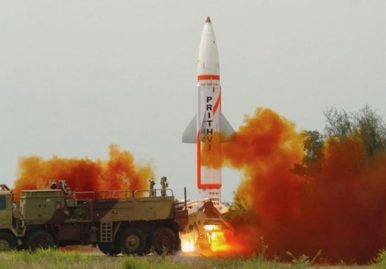For the second time in just a week, India’s Strategic Forces Command (SFC) has test launched a short-range nuclear capable ballistic missile as part of its annual training cycle to test the combat readiness of the Indian Army’s missile forces.
The Prithvi-II tactical surface-to-surface short-range ballistic missile was test fired from the Integrated Test Range (ITR) on Dr. Abdul Kalam Island in the Bay of Bengal off the coast of Odisha on February 7, according to defense sources speaking to local media.
The Prithvi-II, purportedly randomly selected from the Indian Army’s existing stockpile, was launched from a transporter erector launcher. The test was overseen by the SFC and the defense ministry’s Defense Research and Development Organization (DRDO).
“The missile trajectory was tracked by radars, electro-optical tracking systems and telemetry stations by the DRDO along the coast of Odisha,” defense sources said.
All test objectives were reportedly met.
The single-state, liquid fuel missile, developed by DRDO in the 1990s and early 2000s under the so-called Integrated Guided Missile Development Program, was first introduced into service in 2003. It has an operational range of around 350 kilometers and can alternatively be armed with a 500-1,000 kilogram conventional or nuclear warhead.
The missile was also test fired in November 2016 and June 2017.
The February 7 missile test follows the test firing of an Agni-I short-range nuclear capable ballistic missile on February 6. According to defense sources, the launch was a “complete success.” The Agni-I has an operational range of 700-900 kilometers and can carry a 1,000-kilogram conventional or nuclear payload.
The Agni-I was last successfully test fired in November 2017.
Both the Agni-I and Prithvi-II are part of the missile arsenal India maintains to uphold its nuclear warfighting doctrine of credible minimum deterrence. As I explained: “India has a No First-Use (NFU) policy and keeps its nuclear warheads de-mated from the actual missiles. India is estimated to possess 120-130 nuclear warheads.”
This January, the SFC also tested India’s most advanced nuclear-capable intercontinental ballistic missile (ICBM), the Agni-V, as I reported:
The Prithvi-II tactical surface-to-surface short-range ballistic missile was test fired from the Integrated Test Range (ITR) on Dr. Abdul Kalam Island in the Bay of Bengal off the coast of Odisha on February 7, according to defense sources speaking to local media.
The Prithvi-II, purportedly randomly selected from the Indian Army’s existing stockpile, was launched from a transporter erector launcher. The test was overseen by the SFC and the defense ministry’s Defense Research and Development Organization (DRDO).
“The missile trajectory was tracked by radars, electro-optical tracking systems and telemetry stations by the DRDO along the coast of Odisha,” defense sources said.
All test objectives were reportedly met.
The single-state, liquid fuel missile, developed by DRDO in the 1990s and early 2000s under the so-called Integrated Guided Missile Development Program, was first introduced into service in 2003. It has an operational range of around 350 kilometers and can alternatively be armed with a 500-1,000 kilogram conventional or nuclear warhead.
The missile was also test fired in November 2016 and June 2017.
The February 7 missile test follows the test firing of an Agni-I short-range nuclear capable ballistic missile on February 6. According to defense sources, the launch was a “complete success.” The Agni-I has an operational range of 700-900 kilometers and can carry a 1,000-kilogram conventional or nuclear payload.
The Agni-I was last successfully test fired in November 2017.
Both the Agni-I and Prithvi-II are part of the missile arsenal India maintains to uphold its nuclear warfighting doctrine of credible minimum deterrence. As I explained: “India has a No First-Use (NFU) policy and keeps its nuclear warheads de-mated from the actual missiles. India is estimated to possess 120-130 nuclear warheads.”
This January, the SFC also tested India’s most advanced nuclear-capable intercontinental ballistic missile (ICBM), the Agni-V, as I reported:
The Agni-V, a three-stage solid fueled missile, has an approximate range of 5,500-5,800 kilometers [the exact range remains classified], and can carry a 1,500-kilogram (3,300-pound) nuclear warhead. India has reportedly also been working on multiple independently targetable reentry vehicles (MIRV) for the Agni-V in order to ensure a credible second-strike capability.While shorter range nuclear capable missiles are designed to deter Pakistan, the Agni-V missile is being developed to field a credible nuclear deterrent against China.

No comments:
Post a Comment